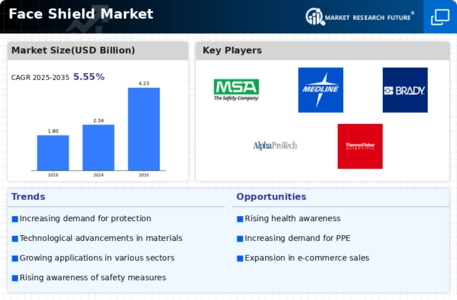Top Industry Leaders in the Face Shield Market

The face shield market, a critical sector within the personal protective equipment (PPE) industry, has witnessed substantial growth as individuals and organizations prioritize safety measures in the face of health challenges. As of 2023, key players in this market have strategically positioned themselves to meet the increasing demand for face shields, offering a variety of designs and features to cater to diverse user needs.
Key Players:
- The 3M Company (US)
- Honeywell International (US)
- MSA Safety (US)
- Medline Industries, Inc. (US)
- Dymax Corp (US)
- Kimberly-Clark Corporation (US)
- Brady Corporation Ltd. (UK)
- Alpha Pro Tech, Ltd. (US)
- Thermo Fisher Scientific (US)
- Shelby Group International, Inc. (US)
Strategies Adopted:
The face shield market deploy various strategies to maintain and enhance their market positions. Product diversification is a common approach, with brands offering face shields with different visor materials, designs, and attachment mechanisms to cater to various user preferences. Marketing strategies include educational campaigns on the proper use of face shields, as well as partnerships with healthcare institutions and government agencies to promote safety protocols. Pricing strategies vary, with some brands positioning themselves as cost-effective options for bulk purchases, while others emphasize premium features such as UV protection or extended coverage. Distribution strategies encompass both traditional channels and online platforms, ensuring accessibility to a broad consumer and industrial customer base. Additionally, brands focus on regulatory compliance, ensuring that their face shields adhere to industry standards and certifications.
Market Share Analysis:
The face shield industry involves evaluating several factors. Brand reputation and reliability play a crucial role, with consumers and businesses opting for well-known and trusted names for their protective equipment needs. The ability to offer a diverse range of face shields suitable for different industries, including healthcare, manufacturing, and construction, contributes to market share growth. Pricing competitiveness, bulk purchase discounts, and responsive customer service impact market share dynamics. Quality of materials used in face shield construction, including clarity, durability, and anti-fog coatings, influences customer satisfaction and brand loyalty. Positive reviews and endorsements from safety professionals and healthcare experts also play a role in shaping brand perception and influencing market share within the highly competitive landscape.
News & Emerging Companies:
The face shield market has seen the emergence of new companies focusing on innovative designs, sustainable materials, and technological integrations. Emerging companies often leverage e-commerce platforms, digital marketing, and collaborations with healthcare professionals to establish their presence in the competitive market. News in this industry typically revolves around new entrants introducing novel face shield designs, efforts to reduce environmental impact through recyclable materials, and investments in technology, such as augmented reality features for enhanced safety.
Industry Trends:
The face shield market often highlights trends in technological innovation, sustainability, and global supply chain management. Companies are increasingly investing in technology, exploring the integration of smart features into face shields, such as communication devices or temperature sensors, to enhance user safety. Current investment trends reveal a focus on sustainability, with brands exploring alternatives to traditional plastic materials, adopting biodegradable options, or implementing recycling programs. Additionally, investments in research and development aim to create face shields with innovative features, such as improved ventilation or antimicrobial coatings, addressing evolving user preferences for enhanced protection.
Competitive Scenario:
The face shield market is characterized by a mix of established conglomerates with a global presence and emerging players focusing on innovation and sustainability. Established brands leverage their extensive research and development capabilities, global supply chain networks, and regulatory compliance to provide consumers and businesses with a diverse selection of face shields. Emerging brands, on the other hand, focus on niche markets, unique designs, and sustainable practices to differentiate themselves in the competitive landscape.
The role of e-commerce has significantly impacted the competitive landscape, allowing both established and emerging brands to reach consumers directly, provide detailed product information, and offer customizable solutions for bulk orders. Brands that effectively utilize digital marketing, optimize the online shopping experience, and engage with consumers through educational content on safety protocols are better positioned to succeed in the evolving market.
Recent Development
The face shield market witnessed a notable development as Honeywell International Inc. introduced a technologically advanced face shield equipped with a heads-up display (HUD) system. This innovation aimed to provide wearers with essential information, such as vital signs or task instructions, without compromising safety. The integration of HUD technology represented a significant advancement in face shield functionality, catering to industries where real-time information is critical. Honeywell's investment in this technology highlighted the industry's response to evolving workplace needs, combining safety with enhanced functionality. The introduction of the HUD-equipped face shield showcased the company's commitment to innovation and providing cutting-edge solutions for diverse industrial applications.


